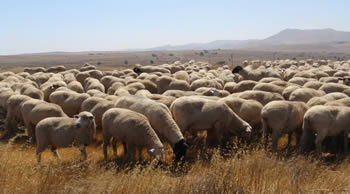Beyond protection lies restoration. Tens of thousands of acres of native vegetation have been “type converted” to weedy species. But promising restoration efforts are now underway.

As a result of overgrazing, repetitive fire, and agriculture, annual grasses and other exotic species have displaced native grasses and shrubs. Complicating the picture is nitrogen deposition from automobile exhaust. Without active assistance, the natives may never return.
On lands owned by the Riverside County Habitat Conservation Agency within the Lake Mathews Reserve, the Natural Resources Manager is conducting an experiment with sheep grazing on 530 acres of old orchards taken over by non-native grasses. The goal is to reduce ground cover to benefit the endangered Stephens’ kangaroo rat and to ultimately reduce seed production, thereby facilitating the return of native grasses.
At Starr Ranch Audubon Sanctuary in southern Orange County, efforts to remove the invasive and resilient artichoke thistle have paid off, and coastal sage scrub has returned to hillsides. This has been done without herbicides by repetitive cutting of re-spouting stems.
On the Palos Verdes Peninsula, habitat restoration is a priority in the NCCP reserve. Extensive revegetation aimed at providing new habitat for the endangered El Segundo blue and Palos Verdes blue butterflies and California gnatcatcher appears to be paying off as populations for these species are on the rise.
The Irvine Ranch Conservancy has proposed a 10-year, landscape level program to restore 2000 acres of degraded land within the 40,000-acre Central/Coastal NCCP. The California gnatcatcher and coastal cactus wren would benefit. Fire control is an integral part of this effort. The City of San Juan Capistrano has also proposed coastal sage scrub restoration to create stepping stones for gnatcatcher breeding and dispersal.
On Marine Corps Base Camp Pendleton, 900 acres of arundo and tamarisk have been removed from streams. These highly invasive species choke out native riparian habitat and are notoriously difficult to eradicate. The endangered least Bell's vireo – a songbird – has responded with a large population increase. Also, the Base is removing exotic fennel from areas burned during the 2007 wildfires.
We hope to learn from these programs, and to achieve ever-broader application.


